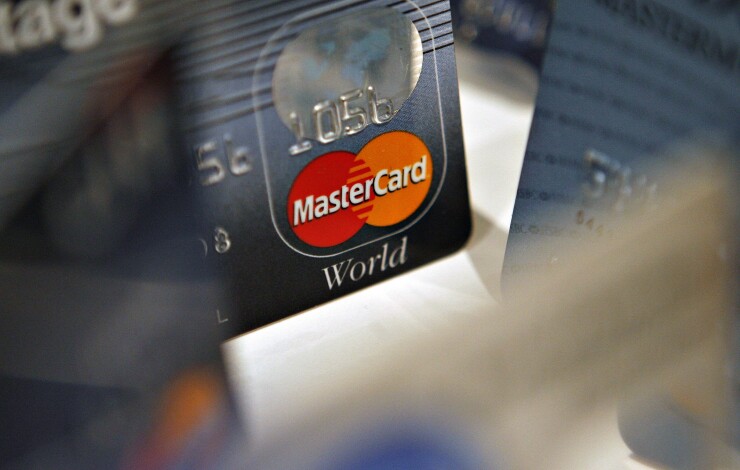Mastercard and MercadoPago, the payments arm of Latin American e-marketplace MercadoLibre, see opportunities for contactless prepaid cards among unbanked consumers even though local issuers have been slow to adopt the format.
MercadoLibre dominates e-commerce in Latin America, with more sales than Amazon in the region, according to
Yet, according to a

“By 2025, we expect 400 million smartphones across Latin America,” said Kiki del Valle, Mastercard’s senior vice president of digital partnerships for Latin America and the Caribbean. “High smartphone penetration and low bancarization levels are driving the development of technologies to facilitate payments in Latin America. These factors make it attractive to fintechs and banks to adopt solutions like contactless to reach the unbanked.”
Since early 2019, MercadoPago has been issuing contactless prepaid Mastercards, following its rollout of contact-based EMV prepaid Mastercards in 2018. As of March 2019, MercadoPago had issued 1.6 million prepaid Mastercards in Argentina, Brazil and Mexico.
“Mastercard’s key goal of partnering with MercadoPago is promoting contactless card issuance,” said Lindsay Lehr, Americas Market Intelligence’s associate managing director. “In 2018, Mastercard mandated that all newly-issued credit, debit and prepaid cards be contactless-enabled by April 2019. Many Latin American issuers, especially in Brazil and Mexico, have resisted this mandate because of the higher cost of contactless cards compared to EMV contact-based cards."
The MercadoPago partnership is one way to get more contactless cards into circulation without depending on issuing banks, Lehr said. "This strategy will likely support Mastercard’s contactless agenda in marketing and messaging only, rather than significantly impacting card issuing, since prepaid cards haven’t been very popular in Latin America.”
Unbanked consumers who use prepaid cards are more likely to use cash when shopping in physical stores, Lehr said.
“Prepaid cards have had most success in e-commerce, as payment via cash is much more complicated, especially for digital purchases like Uber rides, games and video and music streaming," she said. "This is the vertical where MercadoPago’s prepaid Mastercards are likely to gain traction.”
Mastercard has mandated that, after October 2018, all new POS acceptance terminals in Latin America must be EMV chip- and contactless-enabled. Also, by April 2023, all merchant terminals in Latin America must be EMV chip- and contactless-enabled.
Del Valle said that in December 2018, 30% of Latin American POS terminals were contactless-enabled.
“The goal is to get to over 50% in 2019,” she said. “The unbanked get value from using contactless for low-cost transactions like QSR or transit tickets. where consumers currently use cash.”
The countries leading in contactless are Chile, Costa Rica and Colombia — but, from a market size perspective, it’s important to expand contactless issuance in Argentina, Brazil and Mexico, del Valle said.
“Mobile wallets represent only a small percentage of the Latin America payment market, although there are some big name wallets in the region,” she said. “There’s a big opportunity for new players in mobile payments to emerge.”
Visa is promoting contactless issuance in Latin America. In April 2019, Visa formed an alliance with Latin American on-demand home delivery platform
Originally just MercadoLibre’s payments processing platform, MercadoPago also handles payments for other Latin American e-marketplaces and for merchants selling on their own websites or social media. It accepts 70 different online payment types, and processes payments for offline merchants via QR codes on smartphones and via MPoS devices.
“With high smartphone usage in Latin America, we realized MercadoPago should expand from online payments into the physical world,” said Paula Arregui, MercadoPago’s senior vice president of products. “So we built all our solutions on mobile technology including an mPOS platform and a wallet for QR code-based POS payments and P2P transfers.”
MercadoPago has launched a savings account for its prepaid cardholders. “They now get interest credited to them when they keep funds on their prepaid card,” said Arregui. “Offering a way to save money helps people become financially-included.”
During 2019, MercadoPago will implement Mastercard’s biometric authentication and tokenization technologies on its platform.
In Mexico,
“Last year, Banxico introduced
In March 2019,
Arregui said MercadoPago is collaborating with PayPal following its MercadoLibre investment. “It’s good news for us, as there are a lot of synergies between us in Latin America to explore,” she said.
“The deal makes sense for PayPal,” said Jeffrey Bower, principal of Bower & Partners Consulting Services. “As PayPal originally served primarily as a tool for eBay’s U.S. merchants, expanding into Latin America via MercadoLibre, the region’s ‘eBay,’ fits. It also enables PayPal to support merchants who are receiving payments from non-Latin American purchasers, for example enabling funds to pass from the U.S. to Latin America.”




